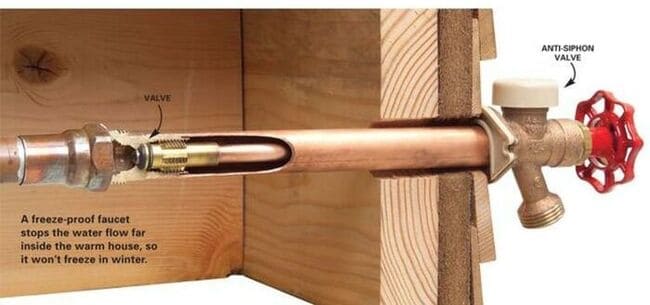Are you trying to decide if getting frost-free hose bibs is worth it? And maybe whether you already have them or not? Let the advice of professional water damage restoration experts help you make the decision. Read on to get quick answers to “Are frost-free hose bibs important?”, and more.
Table of Contents
- What is a Frost-Free Hose Bib?
- Are Frost-Free Hose Bibs Important?
- How Do I Know if My Hose Bib is Frost-Free?
- What If I Didn’t Have One This Last Winter Freeze?
- Preventing Water Damage In Your Home
What is a Frost-Free Hose Bib?
A frost-free hose bib is essentially a long-necked hose bib, or “faucet”. “Faucet” is just another name for “hose bib”. In fact, hose bibs are known by many different names in different regions and countries, including “spigot”, “faucet”, “sill sock”, “outdoor tap”, “exterior faucet”, “hose valve”, and more.
The longer neck (or “stem”) of a frost-free hose bib allows it to accommodate placing the valve that controls the water further back into the house. When the valve that allows water through the hose is inside the walls of the house, it keeps the water inside the house as well. The inside of a building is warmer than the outside in winter. Since the frost-free hose bib keeps the water further inside the building, it’s much less likely to freeze than if it was outside the walls, like with regular hose bibs! And if the water in the hose bib pipe doesn’t freeze, the pipe won’t burst and leak.
Are Frost-Free Hose Bibs Important? Why the Answer is YES.
We can tell you definitively that frost-free hose bibs are important, because it’s our job to clean up the water damage that occurs when regular hose bibs freeze, break, and leak — which happens often. And often, the bill to clean up the catastrophic water damage from a frozen and burst pipe is in the thousands of dollars. Frost-free hose bibs help prevent that from happening.
How Do I Know If My Hose Bib is Frost-Free?
The main difference between a regular hose bib and a frost-free one is that the frost-free hose bib often has a long stem. The stem could also be called the “neck” or the “pipe” part of the faucet. As previously mentioned, the long stem of the frost-free hose bib allows the valve that controls the water to be set further back behind the walls. This helps keep the water from freezing and rupturing the pipe. It should be noted, the longer stem is not always visible from the outside of the building (see photo). If you cannot see that the spigot stem is longer, then follow the steps below.
Another distinguishing difference between a frost-free spigot and a regular one is that properly installed frost-free spigots are installed at a noticeable downward angle. This allows any extra water to drain out of the pipe completely, further ensuring that it won’t freeze and burst.
If you’re still unsure whether your hose bibs are frost-free or not, it’s best to contact your trusted local plumber to ask. You can either ask them to come look at them and tell you, or you can ask if you can send them photos of the hose bibs, and they can tell you that way. Not all plumbers will let you just send them photos, but you can ask.

What If I Didn’t Have One This Last Winter Freeze?
If you’ve determined that you don’t have frost-free spigots, you should be concerned about whether your spigots froze this last winter. Sometimes, regular hose spigots can freeze in the winter, but not burst until spring. They may sit there, frozen, until you turn on your hose bib for the first time this spring, and then the frozen water inside causes damage.
If this is the case for you, you’re likely already dealing with water damage cleanup. This may be why you’re looking into frost-free hose bibs now. But if you haven’t used your hose spigots yet this spring, here’s our advice on how to do your best to prevent any breakage. When you go to turn on our hose bibs, turn them on very, very gradually at first. After a few seconds of opening the tap very slowly, close it again. Repeat these two steps 3-5 times, to help ease water back through the pipe. This will hopefully gently melt any frozen water in the hose bib.
You can purchase frost-free hose bibs at most hardware stores. However, unlike regular hose bibs, frost-free ones will likely require professional installation. This is because the extended stem length and different valve placement often require soldering and special fitting in order to be installed correctly. We recommend you call around to several local plumbers and get quotes on frost-free hose bib installation.
Unsure how to find a good trustworthy plumber? Check out our quick insider guide to vetting service companies.
Preventing Water Damage to Your Home
Water damage can be one of the most costly, wide-reaching, and devastating things to happen to a house. Preventing it should be any property owner’s top priority. Installing frost-free hose bibs is just one of the ways you can prevent such costly, catastrophic damage. We have many other articles on all our insider tips on stopping water damage from happening. Prepare yourself by checking out some of them below!
➜ The top 8 ways to prevent frozen or burst pipes (one of our most popular articles!)
➜ What to do if a water pipe bursts (crucial first steps)
➜ All the different ways you can winterize your home (the professional way)
➜ Everything you need to know about how water damage can cause mold (and how to prevent it!)
Or, visit our entire blog here, for all kinds of useful information that can save you thousands and thousands of dollars!
If you find yourself in the unfortunate position of needing a professional water damage restoration company in Western Washington State, consider Cleaner Guys as a high-quality, well-trusted option. We’re proud to boast award-winning customer service, lower prices than others, and top-notch workmanship! Contact us today through the menu at the top of your screen.

Disclaimer: This article is for informational purposes only. No part of this article is medical or legal advice, and may not be used as such. For all serious medical matters, consult your doctor. For all serious legal matters, consult your legal advisor. This article contains Cleaner Guys’ experience and opinions only.


